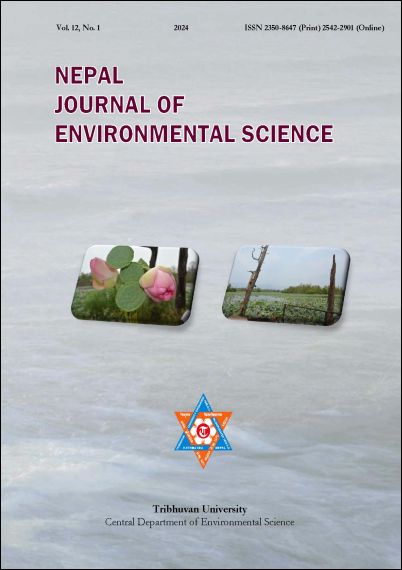Air pollutant dispersion using advection-diffusion equation
DOI:
https://doi.org/10.3126/njes.v12i1.47531Keywords:
Advection–diffusion equation, analytical solution, Gaussian plume modelAbstract
The advection-diffusion model is one of the mathematical models that may be used to understand how air pollutants are spread in the environment. It uses the advection-diffusion system with time-dependent prediction of the spread of environmental contamination under various environmental conditions to determine whether the contaminants are more concentrated at ground level or close to the point of emissions. The times, diffusivity, emission sources, and wind profile are all considered by the model. In order to determine the approach’s descriptive characteristics in terms of advection and dispersion coefficients, we evaluate the exact solution to a flow field problem as an initial value problem in space.
Downloads
References
Abolfazl, M., Mehrdad, M., & Ali, M. (2011). Numerical solution of one-dimensional advection-diffusion equation using simultaneously temporal and spatial weighted parameters. Australian Journal of Basic and Applied Sciences, 5(6), 1536-1543.
Andallah, L.S., & Khatun, M.R. (2020). Numerical solution of advection diffusion equation using finite difference schemes. Bangladesh Journal of Scientific and Industrial Research, 55(1), 15-22. https://doi.org/10.3329/bjsir.v55i1.46728
Appadu, A.R. (2013). Numerical solution of the 1D advection-diffusion equation using standard and nonstandard finite difference schemes. Journal of Applied Mathematics, 14, 734374. https://doi.org/10.1155/2013/734374
Daly, A., & Zannetti, P. (2007). Air pollution modelling - An overview, the EnviroComp Institute, Fremont, CA (USA).
Goyal, P., & Kumar, A. (2011). Mathematical modeling of air pollutants: An application to Indian urban city, centre for atmospheric sciences, Indian institute of technology Delhi, India. https://doi.org/10.5772/16840
Guvanasen, V., & Volker, R.E. (1983). Numerical solution for solute transport in unconfined aquifers. International Journal of Numerical Meth Fluids, 3(2), 103-123. https://doi.org/10.1002/fld.1650030203
Haluk, A.K., & Sertac, C. (2019). Analytical and numerical solution of the 1D advection-diffusion equation, 5th International Conference on Advances in Mechanical Engineering Istanbul.
Hanna, R.S., Briggs, G.A., & Hosker, R.P. (1982). Handbook on atmospheric diffusion, Technical Information Center, U.S Department of Energy. https://doi.org/10.2172/5591108
Isenberg, J., & Gutfinger, C. ( 1972). Heat transfer to a draining film. International Journal of Heat and Mass Transfer, 16(2), 505-512. https://doi.org/10.1016/0017-9310(73)90075-6
Kafle, J., Adhikari, K.P., Paudel, E.P., & Pant, R.R. (2024). Mathematical Modeling of Pollutants Dispersion in the Atmosphere. Journal of Nepal Mathematical Society, 7(1). https://doi.org/10.3126/jnms.v7i1.67487
Karahan, H. (2006). Solution of weighted finite difference techniques with the advection diffusion equation using spreadsheets. Computer Applications in Engineering Education, 16(2), 147-156. https://doi.org/10.1002/cae.20140
Khaled, S.M., Etman, S.M., & El-Otaify, M.S. (2014). Modeling of atmospheric dispersion with dry deposition: An application on a research reactor. Mathematics and Theoretical Physics Department (NRC/AEA), Cairo, Egypt, 29, 331-337. https://doi.org/10.1590/0102-778620130654
Parlarge, J.Y. (1980). Water transport in soils. Annual Review of Fluid Mechanics, 12(1), 77-102. https://doi.org/10.1146/annurev.fl.12.010180.000453
Sankaranarayanan, S., Shankar, N.J., & Cheong, H.F. (1998). Three dimensional finite difference model for transport of conservative pollutants. Ocean Engineering, 25(6), 425-442. https://doi.org/10.1016/S0029-8018(97)00008-5
Singh, K.M., & Tanaka, M. (2000). Exponential variable transformation based boundary element formulation for advection diffusion problems. Engineering Analysis with Boundary Elements, 24(3), 225-235. https://doi.org/10.1016/S0955-7997(00)00003-5
Subbiah, V. (2012). Performance evaluation of ISCST3 model in Noth Chennai coastal environment in predicting SO2. Department of Civil Engineering.
Thongmoon, M., & Mckibbin, R. (2006). A comparison of some numerical methods for the advection diffusion equation. Research letter in the Information and Mathematical Sciences, 10, 49-62.
Zlatev, Z., Berkowicz, R., & Prahm, L.P. (1984). Implementation of a variable stepsize variable formula in the time-integration part of a code for treatment of long-range transport of air pollutants. Journal of Computational Physics, 55(2), 278-301. https://doi.org/10.1016/0021-9991(84)90007-X
Downloads
Published
How to Cite
Issue
Section
License
Copyright (c) 2024 Central Department of Environmental Science, Tribhuvan University

This work is licensed under a Creative Commons Attribution-NonCommercial 4.0 International License.
This license enables reusers to distribute, remix, adapt, and build upon the material in any medium or format for noncommercial purposes only, and only so long as attribution is given to the creator.

